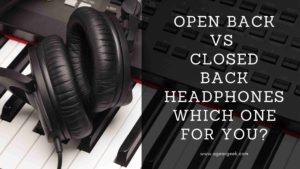Microphones are essential for delivering the right sound for that brilliant composition of yours. With more and more musicians and artists now setting up mini home studios, having the right microphone is essential to provide you with that studio grade sound which at home is difficult to achieve. Let’s dive in and check out some of the best microphones for home studios.
Disclaimer: We’re an affiliate. We hope you love the products we recommend! This post contains affiliate links. If you use these links to buy the products, we may earn a commission from the qualified sales. These are at no additional cost to you. Thank you if you use our links, we really appreciate it!
Types of Microphones
Microphones can be broadly categorized into 3 types
Dynamic Microphones: Dynamic microphones are a great choice to record electric guitars and drums. They are less sensitive and captures the loud frequencies a lot better. These are generally unidirectional or cardioid pattern mics. But they are also used for vocals too. There are a few well-known dynamic microphones that vocal artists swear by and which we will cover later.
Condenser Microphones: Condenser microphones are more sensitive and are used extensively for vocals and other instruments. Among these, you have the Small Diaphragm Condensers (SDC). These are also called the pencil microphones as they are small and cylindrical in shape. These are great options to capture brighter sounding instruments like acoustic guitars and cymbals.
Then there are the Large Diaphragm Condenser mics (LDC) which are great for more detailed sound and work very well for vocals. These are more sensitive microphones and need more isolation for a great quality recording. These microphones can capture and highlight the lows and depths and provide a high-quality recording experience.
Ribbon Microphones: Ribbon microphones are the oldest of these lots. These were the first kind of directional microphones used by the Radio. The modern options of these microphones are the most sensitive of all the three and can virtually pick up any sound. These are normally used for a warm vintage sound. These are especially great for vocals and wind instruments and generally carry a higher price tag.
Interface
Unlike the USB microphones which are used for podcasts, home studios for recording music are best done on XLR ones. So, in such a case you will require a preamp or an audio interface. An audio interface helps to route the sound signals to your computer.
There are some great options available and I prefer the Universal Audio UAD Apollo Twin MkII. This provides an incredible audio experience and is meant for those to whom perfection matters the most. You can get more details below.
No products found.
So, with this background and understanding of microphones, let’s get started on the best ones for home studios.
Shure SM7B
The Shure SM7B is a classic microphone and has been used in plenty of recordings.
No products found.
It is a Dynamic Microphone with a Cardioid pattern. The cardioid pattern means the microphone is designed to capture sounds from one direction. The sounds from any other direction are rejected and not captured equally.
The Shure SM7B offers the artist three frequency responses:
- Flat: This will be appealing to professionals who would like natural audio reproduction.
- Bass Rolloff: This slightly highlights the lower frequencies.
- Presence Boost: Gently amplifies the mids and the treble.
This microphone provides clear vocals and off axis rejection helps to mitigate any unwanted background. This makes it a perfect choice for home studios where studio quality sound proofing might not always be possible.
As expected from Shure the microphone feels premium when unpacked. The microphone comes with a very effective pre-installed pop filter.
This is a great microphone for vocals, instruments and also a great choice for podcasters as well. A good addition for anyone planning to own a microphone.
AEA KU 5A
This is a ribbon microphone. Unlike Ribbon mics requiring a high gain preamp, AEA KU5A has inbuilt active electronics by which you can use this mic with any preamp.
It is a super-cardioid microphone and as expected from AEA the microphone is premium built quality. 20 cm in length and 8 cm in diameter, it weighs 1.2 kgs. The delivery of the smooth sound leaves no question in your mind if the quality delivered is as per the price charged.
No products found.
It is almost like a boutique product made to high standards for individuals who appreciate the distinctive high-quality sound. It delivers the classic warm tone often associated with high-class ribbon microphones but at a price that is not necessarily cheap.
Audio Technica AT 4040
This is a Large Diaphragm Condenser Microphone and has earned successful followership over the years. It offers three switchable polar patterns – cardioid, bidirectional and omnidirectional.
The AT 4050 has a unique quality of warming sounds. It works perfectly fine with not only vocals but also with drums, guitars, and piano (and other instruments as well). If you pair this with a tube amp, this can warm up otherwise thin-sounding instruments like smaller acoustic guitars and make the sound a lot fuller.
No products found.
It has an impressive SPL and thus is able to handle a wide variety of sounds.
It has a great high pass filter and perhaps one of the best in cutting off any low-end rumble and helps in producing a clear crisp sound.
The built of the microphone is superb ensuring durability. It is built like a tank and for sure will last a long time.
Overall a very flexible microphone that opens up many possibilities to a music composer. It could be used by a wide genre of music producers. A great piece to have for home studios.
Neumann TLM 103
This is again a large-diaphragm condenser microphone manufactured by a company that is synonymous with quality. Neumann engineering has been the go-to company for large recording studios due to the superior quality the company stands for.
The TLM 103 is a cardioid with a pressure gradient transducer. This means its inner membrane is responsive to the differential in the pressure of both the front and the back. It has a strong off-axis sound rejection making this microphone reducing any wanted background noise.
No products found.
This microphone is also able to pick up ultra-low sound of 7dB. The microphone boasts a nice and bright sound and especially the added presence around the mids. Moving closer to the microphone boosts the bass frequencies.
The microphone is well built but not too heavy. As true for any Neumann this is not a cheap option. But you get a premium product which most of the top grade recording studios will boast of.
Warm Audio WA-47
This is a large diaphragm tube condenser microphone which aims at achieving the classic sound of Neumann U47. It has 9 polar patterns – cardioid, Omni, Figure 8 and six other mixed patterns.
This is a great sounding microphone and is a perfect fit for home studios, professional studios, and as well as for live shows. Kind of an allrounder of a microphone.
No products found.
The WA – 47 was initially designed to sound like the Neumann U47. It has greatly succeeded in achieving this without the heavy price tag.
The build quality of the WA 47 is detailed and high. It is quite a hefty piece and worth investing on a good stand.
Though the WA47 works great as a microphone for vocalists but it is not limited to vocals. This microphone can be used in diverse settings with instruments from brass to percussion and delivers a great sound. A brilliant piece to collect and have in the arsenal for a home studio.
To Sum Up
This article provides a range of microphones for home studios from being expensive to moderate. But this does not mean the moderately expensive microphones do not make the cut. On the contrary, they have been used in professional studio settings for years and have faithful followership.
While the mid-segment ones will meet the requirements of most, but there will be some who would want to own not only a microphone but also a piece of art like the AEA KU 5A. Follow your heart.
Last update on 2025-06-03 / Affiliate links / Images from Amazon Product Advertising API






Pingback: Home Recording Studio Essentials for Beginners - A Gear Geek
Pingback: 20 Gifts for Guitar Players which they will Love - A Gear Geek